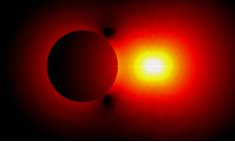Open resonators
Enhancing the light-matter interaction is of utmost importance in quantum science, because single quantum objects such as quantum dots typically interact only weakly with light and their emission of photons is rather undirected. Using optical resonators, this interaction can be enhanced by three options: Decreasing the radiative linewidth, avoiding quenching, and increasing the local electromagnetic fields.
For decades, it has been assumed that the optical resonators can be considered as closed systems that do not radiate light into the far field. However, this assumption is not correct for many realistic systems such as photonic crystal cavitites, cavitites based on distributed Bragg reflectors, and nanoantenna-based resonators. Only recently, a solid theoretical framework has been established for such systems. Our aim is to investigate and employ the many possibilities that arise within this framework in open resonators, including intriguing effects such as complex mode volumes, exceptional points, bound states in the continuum, and extremely high as well as complex local electromagnetic fields.
